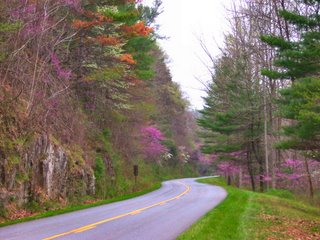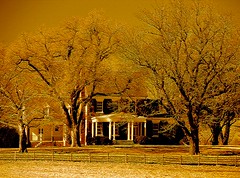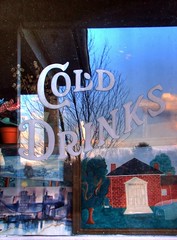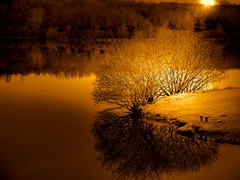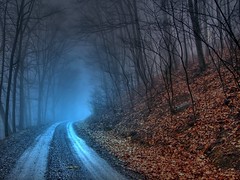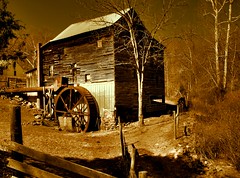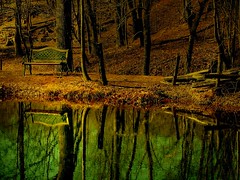A Couple of Spring Blooming Trees in the Blue Ridge

Image: by D L Ennis, Eastern Redbud (Cercis Canadensis)
A leisurely drive on the Blue Ridge Parkway in the spring is a relaxing, even meditative, experience if you can get in touch with your spiritual side and allow your senses to guide the way. Take in the freshness of the cool spring air and keep your eyes alert to what is going on around you. Yes, watch the road, but you can be safe and take in the beauty that abounds.
Spring is the time when creamy-white flowers of the Dogwood (Cornus florida) from an umbrella over the winter skeleton of this beautiful little tree. I think that nearly everyone can identify this tree when it is in bloom, but, there is another tree that blooms at about the same time that I still hear people ask what it is. That tree would be the Eastern redbud which the buds are not red at all; they range from a rosy-pink to lavender to mauve; there is even a white flowering one though it is less common.
The dogwood together with the Eastern redbud is one of my favorite spring combinations. When
 you can find them growing next to one another, as they do in my gardens, they make a gorgeous bouquet of color and textural contrast!
you can find them growing next to one another, as they do in my gardens, they make a gorgeous bouquet of color and textural contrast!Image: by D L Ennis, Eastern Redbud (Cercis Canadensis) and Dogwood (Cornus florida) together. Click image to enlarge.
The Eastern Redbud, (Cercis canadensis,) is common from southernmost Canada to piedmont Alabama and East Texas. In the wild, Eastern redbud is a frequent native under-story tree in mixed forests and hedgerows. It is also much planted as a landscape ornamental plant.
It typically grows to 8-12 m tall, with a short, often twisted trunk and spreading branches. The bark is dark in color, smooth, later scaly with ridges somewhat apparent, sometimes with maroon patches. The twigs are slender and zigzag, nearly black in color, spotted with lighter lenticels. The winter buds are tiny, rounded and dark red to chestnut in color. The leaves are alternate, simple, cordate in shape with an entire margin, 7-12cm (3-5 inches) long and wide, thin and papery, and may be slightly hairy below.
The flowers are showy, light to dark pink in color, 1.5 cm (½ inch) long, appearing in clusters from March to May, on bare stems before the leaves. The flowers are pollinated by long-tongued bees such as blueberry bees and carpenter bees. Short-tongued bees apparently cannot reach the nectaries. The flowers are used in salads and for making pickled relish, while the inner bark of twigs gives a mustard-yellow dye used to dye wool.
The fruit are flattened, dry, brown, pea-like pods, 5-10 cm (2-4 inches) long that contain flat, elliptical, brown seeds 6 mm (¼ inch) long, maturing in August to October.
Though some folks in the United States call the Eastern Redbud (Cercis Canadensis,) the Judas-tree, though it really make no difference, they are technically wrong. The Judas-tree (Cercis siliquastrum) is a small tree to 10-15 m tall native to the south of Europe and southwest Asia, in Iberia, southern France, Italy, Greece and Asia Minor, which forms a handsome low tree with a flat spreading head. In early spring it is covered with a profusion of magenta pink flowers, which appear before the leaves. The flowers have an agreeably acidic bite, and are eaten in mixed salad or made into fritters. The tree was frequently featured in the 16th and 17th century herbals. The elaborate mediaeval mythology that developed around the figure of Judas Iscariot (Died c. A.D. 30) would have had him hang himself from this tree, which may suggest that it was among the European trees that had some pre-Christian cultic significance.
Judas Iscariot (jooh-duhs i-skar-ee-uht) was one of the 12 Apostles; the Apostle who betrayed Jesus to the authorities for thirty pieces of silver in the New Testament. When soldiers came to arrest Jesus, Judas identified their victim by kissing him. The next day, driven by guilt, Judas hanged himself.
The Judas tree was considered a favorite of witches, perhaps on account of its traditional association with the apostle Judas Iscariot. It was considered foolhardy to approach a Judas tree after nightfall.
Technorati Tags: [Blue Ridge Parkway][Dogwood][Eastern redbud][Canada][Alabama][Texas][Judas-tree][Europe][Asia][Iberia][France][Italy][Greece][Asia Minor][Judas Iscariot][United States]



